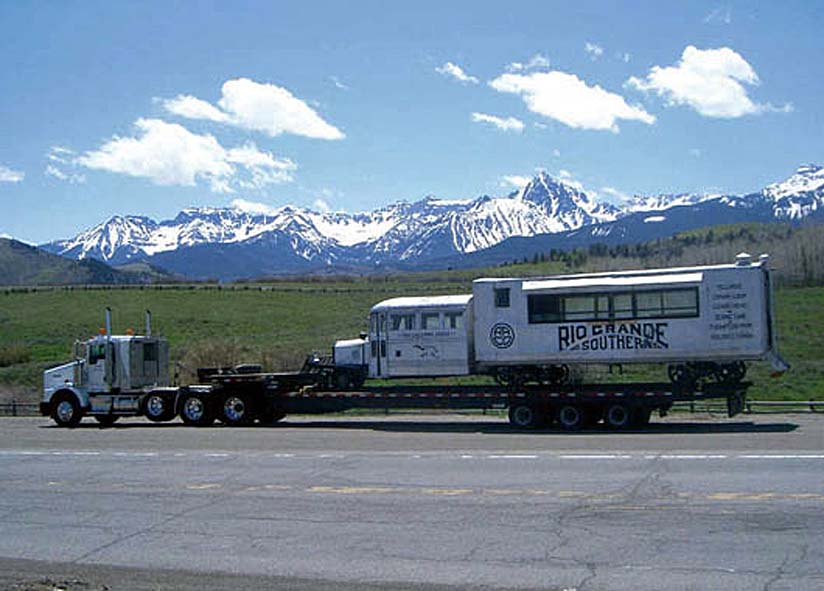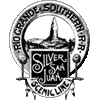

Ridgway Colorado USA - The Ridgway Railroad Museum has a new 43-foot-long, 15,000 pound foster child, Telluride's Galloping Goose Number 4.
The museum has temporary custody of the rail bus that was built in the Ridgway railroad shops in 1932.
The Town of Telluride purchased this Goose from the Rio Grande Southern Railroad a year or so after the RGS ceased operations in 1951.
The Telluride Volunteer Fire Department, official owner and guardian, recently signed a contract with the museum for a comprehensive, non-operating restoration of No. 4.
Under the terms of the agreement, the Goose will return home to Telluride when the restoration is completed.
Museum president Karl Schaeffer estimated the work could take up to three years.
Some 40 people gathered near the San Miguel County Courthouse last Thursday to watch museum and fire department volunteers winch the goose onto a flatbed truck.
About two hours later, a welcoming committee of about 25 greeted the moving team at the Ridgway Railroad Museum.
The spectators cheered and clapped as the Goose landed securely on the museum track.
Schaeffer rang the bell, proving that at least some part of the old bird still works.
"I figure we have about 5,000 hours of work ahead of us. First we have to take measurements and pictures and document its condition in great detail. Then we'll have to build onto our track so we can separate the pieces for cleaning and evaluation," he said.
The volunteers will study archival photographs of No. 4 in its younger days and consult with the Galloping Goose Historical Society in Dolores, which has restored Goose No. 5 to operating condition.
In keeping with historic restoration standards, they will try to repair and reuse original materials, such as the galvanized tin siding on the passenger box.
Telluride's decision to restore the Goose is significant in that Goose No. 4 is the only one in the fleet of seven that has not been restored or modified.
(The Ridgway Museum's fully operable Goose No. 1 is a replica built by Schaeffer in 2000.)
The restoration agreement is the result of nearly a year of talks between the Ridgway Railroad Museum and the Telluride owners.
Longtime Telluride resident and railroad history buff Mary Ann Gaston put pressure on all the parties.
"I knew the Goose wouldn't last forever if we didn't do something. But I also knew that no one in Telluride would ever give it up. I proposed that it be stabilized and restored, then returned. I wouldn't take no for an answer," she said.
Jamey Schuler, chief of the Telluride VFD, supported the idea but acknowledged, "The fire department moves slowly unless there are flames involved. I feel confident that Karl and his volunteers will do an awesome job," he added.
He is not certain exactly where the Goose will reside within Telluride once the work is completed.
He has asked the San Miguel County Commissioners for permission to return the Goose to its previous site near the courthouse or for "another suitable location where it will be accessible to tourists."
While the Ridgway Museum is volunteering time and labor, the Telluride VFD is footing the bill.
Schaeffer's ballpark estimate of the cost comes to US$30,000, which will be billed on a quarterly basis.
Schuler noted that the volunteer firefighters themselves, rather than tax payers, are funding the restoration.
"We paid US$250 for the Goose when it was off the rails," said Schuler.
Railroad records show the Goose was built for a cost of US$2,584.
Apparently it was money well spent.
Like the other Geese, it was built to carry mail, light freight, and a few passengers as a means of raising revenue for the railroad during the Depression era.
These gas-engine rail buses, constructed of used automobiles, kept the RGS in business for another 20 years.
The strange hybrids capably traversed the 162 mile route from Ridgway to Durango.
Simply called "motors" in railroad parlance, they were unofficially christened Galloping Geese due to their wobbling, ungainly gait on the tracks, according to Railroad Museum historian Jim Pettengill.
The original Motor NO. 4 had a Pierce Arrow body and engine.
The current version has a six-cylinder GMC engine, taken from a war surplus truck, and a Wayne Bus body.
The Goose was converted in Ridgway after World War II for tourist use.
The "box" portion includes a stove to keep passengers warm and seats from an old Denver bus.
"It was a last-ditch effort to keep the railroad alive after the mail contract was lost," said Schaeffer.
Hauling tourists, however, didn't prove profitable enough to save the railroad, which died, except in spirit, in 1951.
Schaeffer has a personal connection to the Goose's brief tourist career.
In the summer of 1951, his parents rode on one of its last rounds.
They were so impressed with the views that they decided on the spot to move from Oklahoma to Colorado.
Karl was there too, his mother was pregnant at the time.
His father, Bob Schaeffer, remembered that fateful trip as he watched the Goose arrive in Ridgway last week.
"I looked at Trout Lake," he said, "and decided I had to live here.
Author unknown.
provisions in Section 29 of the Canadian
Copyright Modernization Act.










